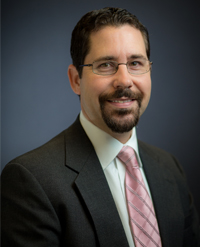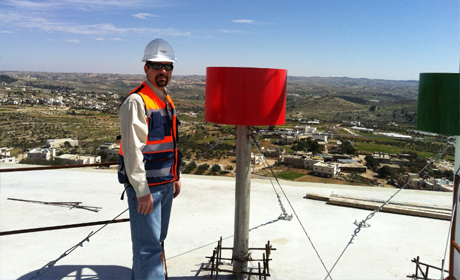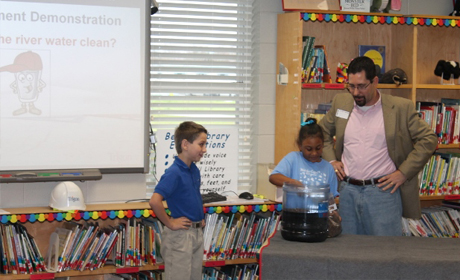News
News
News
- Details
Transportation engineering graduate student Michael Levin was recently awarded the Council of University Transportation Centers (CUTC) Milton Pikarsky Memorial Award for his M.S. thesis on autonomous vehicle modeling.
The Milton Pikarsky Memorial Award is a national award given annually for the best Ph.D. dissertation and M.S. thesis in the field of science and technology in transportation studies. Winners in the M.S. thesis category receive a $1500 honorarium.
Levin’s award-winning thesis “Integrating Autonomous Vehicle Behavior into Planning Models” makes three important contributions to the field:
- Autonomous vehicles are incorporated into the traditional four-step planning model, accounting for both increases in capacity due to faster reaction times as well as additional demand due to empty relocation trips.
- Building towards a dynamic traffic assignment (DTA) model, drivers' choice of departure time is integrated into the existing four steps.
- Building on the first two points, novel intersection controls for autonomous vehicles are proposed.
Levin, now a Ph.D. candidate, is supervised by Dr. Stephen Boyles and is a graduate research assistant at the Center for Transportation Research.
- Details
The following graduate students received a $1,000 Kolodzey Travel Grant for the Fall 2015 semester. The award provides an opportunity for PhD students in the Department of Civil, Architectural, and Environmental Engineering to attend technical conferences, make oral and poster presentations about their dissertation research, and to develop a network of colleagues at other universities. Students are selected by a committee comprised of faculty from each area of specialization.
Fall 2015
- Matthew Hiatt - Environmental & Water Resources Engineering
- Wing Shun Kwan - Geotechnical Engineering
- Gaston Quaglia - Geotechnical Engineering
- Tarun Rambha - Transportation Engineering
- David Teague - Geotechinical Engineering
- Details

Greg Kolenovksy (BSCE 1998)
Established in 2003, the Outstanding Young Alumnus/Alumna award recognizes a graduate of the Civil, Architectural and Environmental Engineering department under the age of 40 who has distinguished himself or herself with outstanding service and contributions to the engineering profession and community.
Gregory A. Kolenovksy (BSCE 1998) is Vice President of Trigon Associates, LLC, an engineering consulting firm based in New Orleans that he co-founded in 2009. As one of the owners, he is involved with many aspects of the business but primarily oversees project delivery and business development activities. Most of his professional experience has revolved around municipal infrastructure such as water, wastewater, drainage and roads. Outside of the US, he has also worked on projects in the Middle East and Haiti.

Kolenovsky is a licensed PE in eight states and is certified by the Project Management Institute as both a Project Management Professional and a Program Management Professional, having been one of the first few hundred certified PgMPs in the world.
His expertise includes system analysis, troubleshooting and computer modeling of hydrologic and water resource systems, water distribution and wastewater collection systems, as well as engineering and design of various public infrastructure projects, including pumping systems; collection/distribution systems and treatment plants; streets and roadways; and municipal buildings and facilities.
He has worked on multiple master planning efforts for both wastewater systems and potable water systems and is also experienced with emergency management efforts, particularly disaster recovery and hazard mitigation projects related to infrastructure.
Kolenovsky is active in many professional organizations and has received numerous awards for community service activities. He enjoys teaching children about engineering - he provides presentations and hands-on demonstrations at schools and frequently mentors civil and environmental engineering students.

He has served on the department's External Advisory Committee since the Fall of 2013 and established the Kolenovsky Family Endowed Legacy Fund for Engineering Excellence in Civil, Architectural and Environmental Engineering.
For more information about this award or to read about past recipients, please visit our Outstanding Young Alumni page.
Questions? Please contact Alumni Coordinator
- Details
The Construction Industry Institute (CII), a research consortium based in the Cockrell School of Engineering at The University of Texas at Austin, has signed a three-year, $3 million agreement with the Singapore Economic Development Board to help the country’s energy and chemicals industry construct and maintain more efficient processing facilities.
The partnership between UT Austin’s researchers at CII and the government and companies in Singapore is intended to accelerate a shift in the industry’s approach to maintenance and construction productivity with the goal of making Singapore more competitive and reducing its reliance on foreign labor. Singapore is widely considered one of the top petrochemical and refining centers in the world.
CII researchers will lend their expertise in the construction, maintenance and shutdown/turnaround of refineries and chemical plants. Researchers plan to assess the country’s needs and guide Singapore in the use of new technologies, materials and construction management practices.
Carlos Caldas, professor in the Cockrell School’s Department of Civil, Architectural and Environmental Engineering, and Stephen Mulva, CII’s associate director and a Cockrell School lecturer, are the principal investigators on the project.
The UT Austin team, which won the project in a global selection process, will be working with researchers from the National University of Singapore.
“Construction productivity is a worldwide problem,” Mulva said. “We think the expertise that we have garnered through our decades of global research can be of great benefit to one of Singapore’s vital industries. There is no better way to ‘change the world’ — as we like to say at UT Austin — than to partner with people in other continents and work to make things better for society.”
The research will draw on the CII Performance Assessment Program and the findings of CII’s landmark RT 252 Construction Productivity Research Program, a six-year effort concluded in 2013 that examined technologies and best practices for construction productivity improvement.
The study will investigate the use of productivity measurement practices such as benchmarking to gauge the productivity of different construction disciplines. The researchers are also proposing a novel method of assessing mechanization, which will play an important role in determining the appropriate amount and types of technology needed to optimize productivity.
The research team will develop and evaluate the proposed measurement and management practices across 15 pilot projects and then use the research findings to transfer knowledge to the industry through annual workshops.
“The research findings will give Singapore’s petrochemical industry a clear sense of where it stands globally in terms of productivity, and they will set the stage for its improvement,” Caldas said.
- Details
A team of engineers and health researchers at The University of Texas at Austin plan to shed light on how environmental conditions could affect students’ health, attendance and learning in high school and to offer low-cost, long-term solutions to help schools combat those effects.
The researchers were motivated by mounting scientific evidence that poor indoor air quality and inadequate classroom ventilation contribute to student illness and, therefore, absenteeism and decreases in academic performance. The team’s study will include comprehensive measurements and analyses of air quality, noise levels, lighting and thermal conditions that may be compromising the overall health of students and teachers.
With a $1 million grant from the U.S. Environmental Protection Agency, the UT Austin team plans to study environmental conditions inside six Texas high schools, including over 120 total classrooms. The researchers also plan to test low-cost solutions that will help create a healthier environment and improve the overall educational experience for students. This is one of seven research projects the EPA is funding as part of a larger effort to improve school environments indoors for the nation’s children.
“Our children and teachers spend a substantial amount of their lives inside school buildings,” said air quality expert Richard L. Corsi, chair of the Department of Civil, Architectural and Environmental Engineering at UT Austin. “We believe it is critical to gain a better understanding of this environment and its implications for health and learning, and we hope the solutions we create will be applied in schools across the country, giving our children a better environment for academic success.”
The UT Austin project, called Healthy High School PRIDE (Partnership in Research on Indoor Environments), will help identify common sources of indoor air quality problems in schools, such as poor ventilation, HVAC structural issues and the presence of bacteria and chemical irritants.
Started over the summer, the project is one of the first of its kind to focus on high schools, which are considered more challenging to assess because students are often changing classrooms throughout the school day.
Corsi has assembled a multidisciplinary team consisting of experts in children’s health, indoor air quality, microbiology, building science and community-engaged research to tackle the Texas-based project.
The engineers will provide detailed assessments of three main areas: HVAC systems and ventilation; exposure to bacteria, mold and other allergens; and the presence of potentially harmful particles called Oxygenated Volatile Organic Compounds (OVOCs), which are emitted from furnishings, adhesives, coatings, cleaning agents and other sources. While considered less toxic, OVOCs can irritate eyes, noses and respiratory systems.
Meanwhile, Sharon Horner of the UT Austin School of Nursing, a key investigator in the project, will lead efforts to monitor and track the health of students and teachers who choose to participate in the study.
As part of the NSF-funded project, the UT Austin research team will use indoor air quality studies to engage students in the participating high schools, offering hands-on learning opportunities through student research, workshops and team-based projects. Additionally, teachers will use the study as a basis for new Science, Technology, Engineering and Math (STEM) lessons related to data analysis and indoor environmental science and engineering.
At the end of the four-year grant, Corsi and his team plan to deliver their findings and provide schools and districts with creative yet practical solutions to improve their indoor environments.
“School districts are often very cost-constrained, so we want to make sure we offer ideas for affordable solutions that will help districts improve their schools and make them healthier,” Corsi added.
- Details
Nine alumni inducted into Academy of Distinguished Alumni for outstanding achievements and contributions to society.
- Details
The National Science Foundation (NSF) has selected the Cockrell School of Engineering at The University of Texas at Austin for a $3.8 million grant to support research that aids in the design of buildings and infrastructure that can better withstand earthquakes, hurricanes, storm surges and other natural hazards.
The grant is part of the new Natural Hazards Engineering Research Infrastructure (NHERI) program announced today by the NSF. The five-year program will provide a network of shared, state-of-the-art experimental research facilities located at seven universities across the country.
At UT Austin, the grant will establish NHERI@UTexas, a natural hazards experimental facility aimed at protecting our nation’s existing infrastructure and helping in the planning and design of new infrastructure that is more resilient to earthquakes, hurricanes and other wind and water hazards.
Professor Kenneth Stokoe II and his team, including associate professor Brady Cox and assistant professor Patricia Clayton, will lead NHERI@UTexas.
“The grant will allow us and other NSF-supported researchers to develop new knowledge that will be used to make our nation’s bridges, levees and buildings safer and more resilient,” Stokoe said. “With the resources provided by NHERI, we believe we will make a difference as engineers in preventing natural hazards from becoming natural disasters.”
NHERI@UTexas will advance new methods of earthquake, wind and water hazards research and will have three main focus areas: subsurface imaging, soil characterization and structural evaluation. The key pieces of equipment for this research are NHERI@UTexas’ large, one-of-a-kind mobile shaker trucks called Liquidator and T-Rex. With these mobile shakers, the researchers plan to apply advanced imaging techniques, similar to those used in health care, to image the near-surface of the earth and retrieve engineering design parameters. The information will be used to create computer models that can identify weak spots in levees that could potentially fail in the event of a large earthquake or hurricane.
Additionally, the researchers plan to uncover knowledge about how different soils and foundation systems respond to dynamic loading (forces that change or vary with time), a key to understanding how buildings and infrastructure may perform in an earthquake or extreme wind storm.
The team will also use the large shaker trucks to dynamically test structures in different parts of the U.S. These experiments will not only assist in the design of future infrastructure but could also be used to assess the strength of existing bridges and buildings and predict their life expectancy. The resulting assessment could help city, state and federal officials and policymakers plan for future infrastructure repairs and determine funding priorities.
“At the end of the grant, we hope to have made significant progress toward ensuring that our nation’s existing and future infrastructure is more resilient to the demands of natural hazards,” Cox said. “This will help us retrofit and build sustainable communities.”
Also part of the NHERI program, the NSF is funding a cyberinfrastructure research effort, called DesignSafe, led by Cockrell School Professor Ellen Rathje. UT Austin researchers will develop a software platform, data repository and tools for researchers to advance hazard-resistant design that will improve the safety of people and property.
- Details
Fernanda Leite, assistant professor in the Department of Civil, Architectural and Environmental Engineering at the University of Texas at Austin, was selected to attend the National Academy of Engineering’s (NAE) Frontiers of Engineering Education Symposium.
The Frontiers of Engineering Education (FOEE) Symposium brings together some of the nation’s most engaged and innovative engineering educators to discuss pioneering technical work and research in various engineering fields and industry sectors to inspire a sustained dialogue on engineering education. FOEE faculty members are actively teaching in US engineering programs and have recently implemented significant innovations in their classes. Leite was chosen by NAE through a competitive selection process.
A faculty member since 2010, Leite received her PhD from Carnegie Mellon University. Her technical interests include information technology for project management, building information modeling, visualization, life-cycle information integration, collaboration and coordination technologies, and information technology-supported construction safety management.
Leite teaches courses on project management and economics, building information modeling (BIM) for capital projects, and construction safety. She has integrated project-based learning to all her classes, through course projects, industry mentorships, and interactive exercises.
“By attending the NAE Frontiers of Engineering Education Symposium, I hope to exchange and gain knowledge on leading-edge research and innovation across a variety of engineering disciplines, especially with regards to information-technology supported engineering problems,” says Leite.
“It is always a great pleasure to interact with other individuals who are as passionate as I am about teaching,” she says. “I am excited for the opportunity to meet and learn with other engineering faculty in this year’s symposium. I look forward to hearing what others have been doing to innovate in the classroom and enhance student engagement.”
The two-and-a-half-day symposium will be held Oct. 25-28 at the National Academies’ Beckman Center in Irvine, California.
- Details
The University of Texas at Austin’s Department of Civil, Architectural, and Environmental Engineering is once again ranked in the top 10 in U.S. News & World Report's 2016 undergraduate program rankings, strengthening the department's position as one of the nation’s elite engineering departments.
The undergraduate program in Civil Engineering is ranked No. 6 and the Environmental/Environmental Health Engineering is ranked No. 5.
In addition, the Cockrell School of Engineering is ranked as the No.11 best engineering school in the country, and several of UT Austin’s engineering programs ranked in the nation’s top 10 for their respective programs, according to U.S. News & World Report's annual rankings released on Sept. 9.
View methodology at www.usnews.com/collegemeth.







